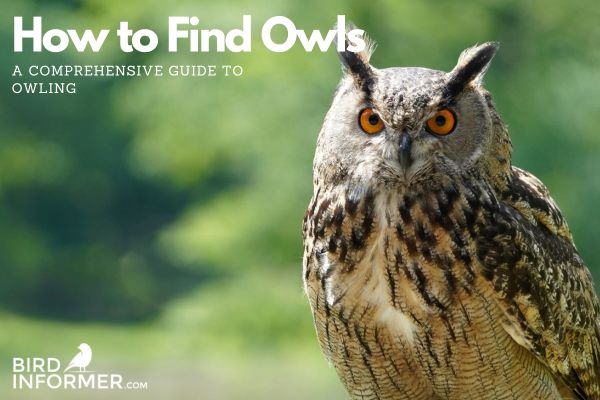Contents
Who doesn’t love the thrill of spotting a majestic owl in the wild? These mysterious, nocturnal creatures have captured our hearts and imaginations, but finding them in their natural habitat can be quite a challenge. Fear not, fellow Owl enthusiasts! We’ve compiled a comprehensive guide on how to find owls and learn about their fascinating lives.
Short Summary
Understand owl species & habitats to spot them in the wild
Best times for owling are dawn/dusk with seasonal changes playing a role too
Utilize online resources, practice ethical habits and follow tips for successful owling!
Understanding Owl Species and Their Habitats
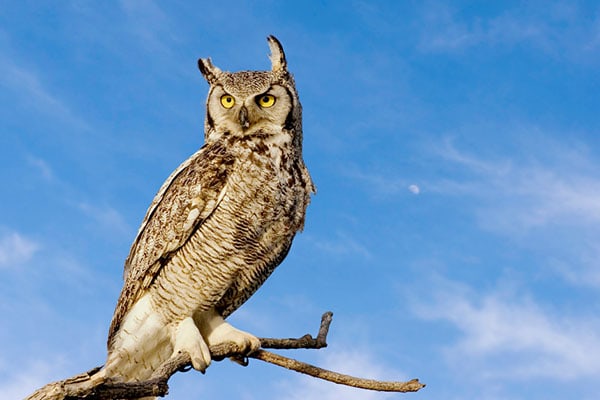
To increase your chances of finding owls, it’s essential to understand the different owl species and their preferred habitats. North America is home to 23 regularly occurring species, including the great horned owl, barred owl, and eastern screech owl. Each species has unique behaviors and habitats where they thrive. For example, wooded habitats and riparian zones near agricultural areas are excellent spots to look for owls like short eared owls, as they provide plenty of prey.
Knowing the range, habitat, and behavior of the species you’re looking for, such as the eastern screech owl, can significantly improve your chances of finding them. A quick Google search for “owls + your location” should give you all the info you need about local owls. To further improve your knowledge, the Peterson Reference Guide to Owls is the best field guide you can get, as it covers various owl species, including the barred owl.
Great Horned Owls
The Great Horned Owl is the most common owl in North America and is known for its large size, prominent ear tufts or “horns,” and an intimidating yellow-eyed stare. These fascinating birds prefer mixed forests, where they can be found in tree cavities or old nests of other large birds.
By understanding the preferred habitats of great horned owls, you can increase your chances of spotting them in the wild. When you venture into mixed forests, keep your eyes peeled for these impressive birds perched in trees or nestled in old nests, and don’t forget to bring your camera to photograph owls in their natural environment.
Barred Owls
Barred Owls are another fascinating species, known for their distinctive hooting calls and striking pattern of white and brownish-gray bars on their back, wings, and tail. These birds typically inhabit dense forests near water sources, such as flood plains, river bottoms, and lake margins. In contrast, the barn owl is known for its heart-shaped face and pale coloring, while barn owls as a group exhibit a variety of unique features and behaviors, including snowy owls with their striking white plumage.
Listening for the unique hooting calls of barred owls can help you locate them in their preferred habitats. With a series of 8-10 hoots in a row, followed by a pause and another series of hoots, their calls can be easily recognized among the sounds of the forest. Keep your ears open, and you might just find a barred owl perched nearby.
Screech Owls
Screech Owls are small, nocturnal birds that can be found in wooded areas and suburban neighborhoods. These owls are common in the eastern US and are about the size of a robin. They have unique vocalizations, like a whinny-like call and a low-pitched trill.
If you live in an area inhabited by screech owls, you might be able to spot them right in your own backyard. Keep an eye out for these small owls during dawn and dusk, when they are most active and hunting for prey. By understanding the behaviors of screech owls and the areas they frequent, you can increase your chances of spotting them in the wild.
Burrowing Owls
Burrowing Owls are unique, ground-dwelling owls with long legs, a short tail, and a round head with bright yellow eyes. They can be spotted in open grasslands, deserts, and agricultural areas of North and South America, where they feed on small mammals, insects, and sometimes birds and reptiles.
These owls are considered a species of conservation concern due to habitat loss and degradation. By understanding their preferred habitats and nesting habits, you can help protect these fascinating birds and enjoy observing them in their natural environment.
Best Times and Places for Owling
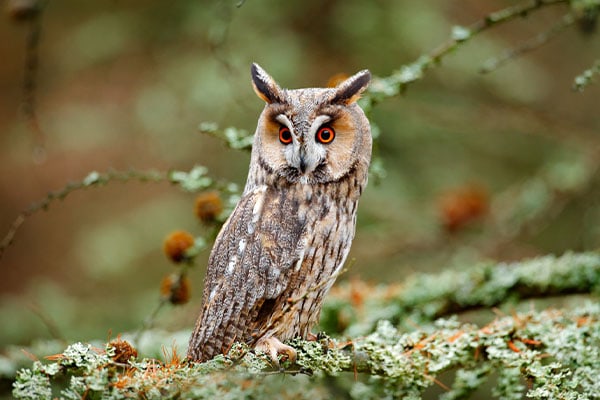
While the specific time and location for owling may vary depending on the species, one thing is certain: dawn and dusk are the best times for owling, as owls are most active during these times. Seasonal changes also affect owling, as some owls migrate to different areas during different times of the year, making late winter and mid-summer to early autumn prime times for catching a glimpse of these mysterious birds.
In the following sections, we’ll dive deeper into the factors that contribute to successful owling, including specific locations and online resources for owl sightings.
Dawn and Dusk
As previously mentioned, owls are most active during dawn and dusk, making these the prime times for owlings. This is when owls are hunting for prey, such as mice, voles, and shrews, and engaging in other fascinating behaviors that make them a delight to observe. During these times, you may also hear songbirds alerting each other of the presence of owls, making it easier to locate them.
To make the most of your owling experience during dawn and dusk, follow these tips.
Stay as quiet and still as possible
Avoid talking or making loud noises
Bring binoculars or a spotting scope to get a better view of these elusive creatures
Seasonal Changes
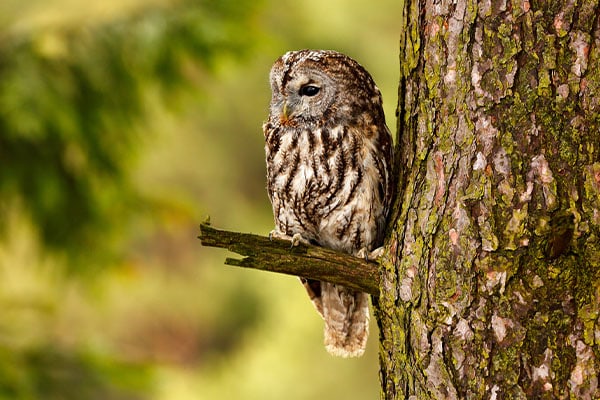
The time of year can greatly impact your chances of spotting owls in the wild. In late winter, owls are busy nesting and hunting for food to feed their young. This makes it an optimal time to observe and listen for their distinctive calls, such as the hooting of barred owls or the eerie whinny-like call of screech owls.
Mid-summer to early autumn is another prime time for owl watching, as many owl species are still actively hunting and tending to their young during this period. Keep in mind that seasonal changes can affect the presence of certain owl species in your area, so it’s important to stay informed about the habits of the specific owls you’re hoping to spot.
Specific Locations
While many owl species can be found in a variety of habitats, some specific locations are more likely to yield successful owl sightings. Wooded habitats, riparian zones, or forest edges near agricultural areas are great spots to look for owls, as they provide plenty of prey. Using online resources like Google Maps in the satellite view can help you identify potential owl spots near you.
Additionally, city parks, national parks, and state parks can also be excellent locations to find owls, as these areas often provide ample trees and open spaces for owls to hunt and nest. So, whether you’re exploring your own backyard or venturing into the great outdoors, there are countless opportunities to spot these majestic creatures in their natural habitat.
Utilizing Online Resources for Owl Sightings
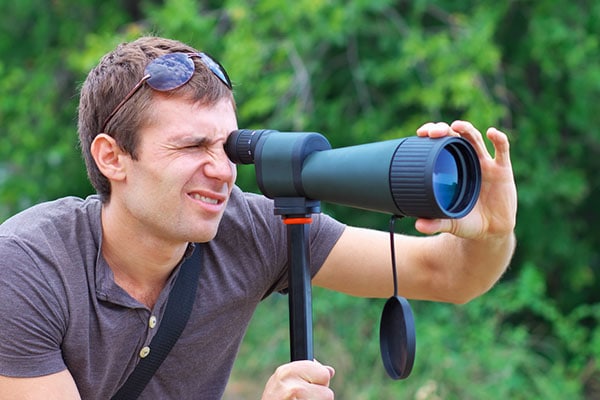
In addition to exploring various habitats and paying attention to the time of day, utilizing online resources can greatly enhance your chances of finding owls. Websites like eBird.org can provide you with recent owl sightings and help you identify species trends in your area.
By staying informed about the presence of owls near you, you’ll be better equipped to locate and observe these fascinating creatures in their natural habitat.
Ethical Owl Watching and Photography

As with any wildlife observation, it’s crucial to practice ethical owl watching and photography. Owls are sensitive creatures, and disturbing them can have negative consequences for both the birds and their environment.
In the following sections, we’ll discuss how to prevent disturbance, keep a safe distance, and respect nesting owls while you enjoy observing these magnificent birds.
Disturbance Prevention
When observing owls, it’s important to:
Move quietly and minimize any potential disturbance
Wear dark clothing and try to stay as quiet and still as possible
Avoid flash photography, as it can startle owls and cause them to fly away or even abandon their nesting sites
Remember, the goal is to observe owls without causing them any distress or harm.
Insect repellant is another essential item to bring along on your owl watching adventures, as it can help prevent unwanted distractions from pesky mosquitoes and other insects. By staying focused and being considerate of the owls and their environment, you can enjoy a memorable and ethical owl watching experience.
Nesting Owl Precautions
When observing nesting owls, it’s crucial to take extra precautions to ensure their safety and well-being. Use a telephoto lens for photography to maintain a safe distance from the nest and avoid using drones, which can cause unnecessary stress and disturbance for the owls.
If you come across a nest or roost site, it’s best to observe it from a distance with binoculars or a scope. Make sure to visit the site no more than once every three to four weeks to minimize any potential disturbance to the owls and their environment.
By taking these precautions, you can help protect these fascinating predatory birds and enjoy observing them in their natural habitat.
Tips for Successful Owling

In addition to understanding owl species, habitats, and ethical practices, there are several tips that can further improve your chances of successful owling. In the following sections, we’ll discuss how to listen for bird alarm calls and explore off-trail to increase your chances of spotting owls in the wild.
Bird Alarm Calls
One helpful tip for locating owls is to pay attention to the alarm calls made by songbirds. When songbirds spot an owl nearby, they often make a series of alarm calls to warn other birds in the vicinity. By listening for these calls, you can often pinpoint the location of an owl perched nearby.
To recognize bird alarm calls, it’s important to get to know the alarm calls of the birds in your area, as they can differ from species to species. With practice, you’ll become more adept at identifying these calls and using them to locate owls in their natural environment.
Off-Trail Exploration
Venturing off-trail can be an excellent strategy for finding owls, as it allows you to cover more ground and investigate potential sources of alarm calls that may be happening in a far-off area. Wilderness areas, old forest roads, and large parks are great places to explore off-trail.
When exploring off-trail, it’s essential to take safety precautions and be mindful of your surroundings and any potential dangers. Wear appropriate clothing and shoes, bring a map and compass, and be aware of local wildlife and their habitats.
With patience and persistence, your off-trail exploration may lead you to a memorable perched owl encounter.
Joining Local Owl Watching Programs
Another great way to improve your owling skills and learn from experienced naturalists is by participating in local owl watching programs or guided walks. These programs can be a valuable resource for learning about:
owl species
habitats
behaviors
tips for locating and observing them in the wild
Reach out to local wildlife refuges, birding festivals, or birding organizations to find out about scheduled owling walks in your area.
Summary
In conclusion, finding owls in their natural habitat can be a thrilling and rewarding experience. By understanding the various owl species and their habitats, exploring during dawn and dusk, utilizing online resources, and practicing ethical owl watching and photography, you can increase your chances of spotting these magnificent creatures in the wild. So grab your binoculars, head out into the great outdoors, and embark on an unforgettable owling adventure!
Frequently Asked Questions
How do you attract owls?
Having trees in your yard, attracting small rodents for owls to eat, offering perching sites, and installing nesting boxes are all good ways to attract owls. Leave grass uncut, add a brush pile, and provide bird baths to make the habitat more friendly for owls.
Adding tall posts and outdoor floodlights may also inspire them to choose your yard as a nesting site.
What is the best time of day to see owls?
The best time to see owls is at dawn or dusk, or on a moonlit night. This is when they’re most active and easier to spot.
How hard is it to find an owl?
Finding an owl can be challenging, as they are well-camouflaged and prefer to hide in dense evergreens. However, with some patience and moving quietly, you may be able to spot one on its daytime roost.
Where are owls usually at?
Owls live in diverse habitats all over the world, ranging from deserts to tundra, and nest in a variety of places such as trees, burrows and caves. Many species, such as the great gray and horned owls, prefer old hawk or squirrel nests.
How do you know if an owl is near?
If you find large feathers on the ground, look them up with a field guide to see if they match an owl species. Pay attention to sound as well, since you might hear them hooting at night or during the day.
Be aware of your surroundings and you’ll know when an owl is near.

